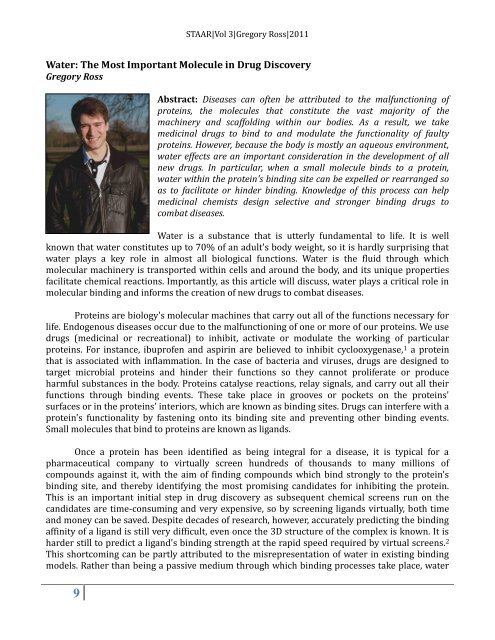STAAR Volume 3 - St. Anne's MCR
STAAR Volume 3 - St. Anne's MCR
STAAR Volume 3 - St. Anne's MCR
Create successful ePaper yourself
Turn your PDF publications into a flip-book with our unique Google optimized e-Paper software.
9<br />
<strong>STAAR</strong>|Vol 3|Gregory Ross|2011<br />
Water: The Most Important Molecule in Drug Discovery<br />
Gregory Ross<br />
Abstract: Diseases can often be attributed to the malfunctioning of<br />
proteins, the molecules that constitute the vast majority of the<br />
machinery and scaffolding within our bodies. As a result, we take<br />
medicinal drugs to bind to and modulate the functionality of faulty<br />
proteins. However, because the body is mostly an aqueous environment,<br />
water effects are an important consideration in the development of all<br />
new drugs. In particular, when a small molecule binds to a protein,<br />
water within the protein's binding site can be expelled or rearranged so<br />
as to facilitate or hinder binding. Knowledge of this process can help<br />
medicinal chemists design selective and stronger binding drugs to<br />
combat diseases.<br />
Water is a substance that is utterly fundamental to life. It is well<br />
known that water constitutes up to 70% of an adult's body weight, so it is hardly surprising that<br />
water plays a key role in almost all biological functions. Water is the fluid through which<br />
molecular machinery is transported within cells and around the body, and its unique properties<br />
facilitate chemical reactions. Importantly, as this article will discuss, water plays a critical role in<br />
molecular binding and informs the creation of new drugs to combat diseases.<br />
Proteins are biology's molecular machines that carry out all of the functions necessary for<br />
life. Endogenous diseases occur due to the malfunctioning of one or more of our proteins. We use<br />
drugs (medicinal or recreational) to inhibit, activate or modulate the working of particular<br />
proteins. For instance, ibuprofen and aspirin are believed to inhibit cyclooxygenase, 1 a protein<br />
that is associated with inflammation. In the case of bacteria and viruses, drugs are designed to<br />
target microbial proteins and hinder their functions so they cannot proliferate or produce<br />
harmful substances in the body. Proteins catalyse reactions, relay signals, and carry out all their<br />
functions through binding events. These take place in grooves or pockets on the proteins'<br />
surfaces or in the proteins' interiors, which are known as binding sites. Drugs can interfere with a<br />
protein's functionality by fastening onto its binding site and preventing other binding events.<br />
Small molecules that bind to proteins are known as ligands.<br />
Once a protein has been identified as being integral for a disease, it is typical for a<br />
pharmaceutical company to virtually screen hundreds of thousands to many millions of<br />
compounds against it, with the aim of finding compounds which bind strongly to the protein's<br />
binding site, and thereby identifying the most promising candidates for inhibiting the protein.<br />
This is an important initial step in drug discovery as subsequent chemical screens run on the<br />
candidates are time-consuming and very expensive, so by screening ligands virtually, both time<br />
and money can be saved. Despite decades of research, however, accurately predicting the binding<br />
affinity of a ligand is still very difficult, even once the 3D structure of the complex is known. It is<br />
harder still to predict a ligand's binding strength at the rapid speed required by virtual screens. 2<br />
This shortcoming can be partly attributed to the misrepresentation of water in existing binding<br />
models. Rather than being a passive medium through which binding processes take place, water


